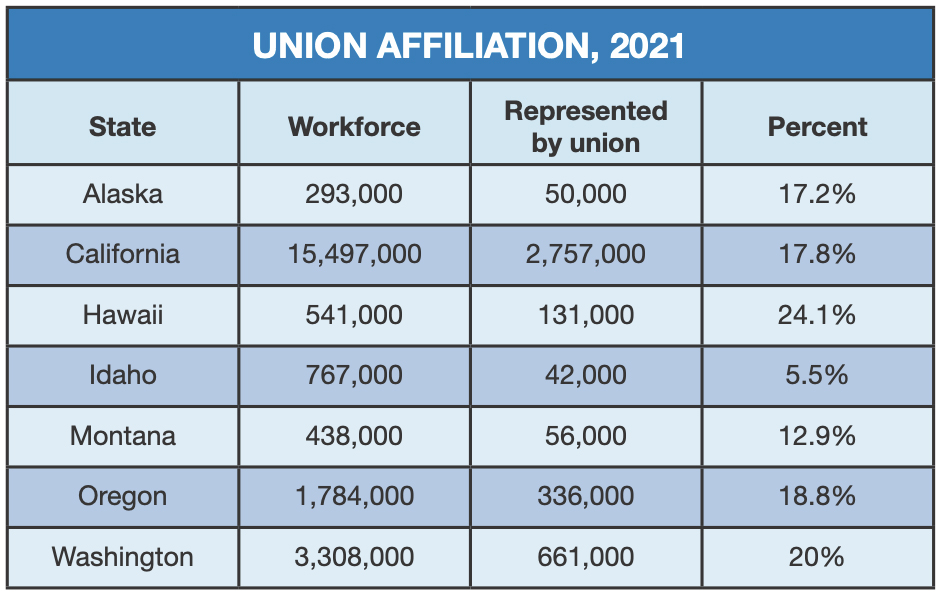A top priority for Washington’s public sector employees will be lobbying the 2023 Legislature to fund contracts negotiated this year by Gov. Jay Inslee’s office.
The contracts cover a wide variety of activities, ranging from professional and technical workers to Teamsters, educators, judges, lawyers, state patrol officers and troopers, fish and wildlife workers, ferry workers and many more.
The Washington Policy Center calculates the obligations at $1 billion, based on information posted by the Office of Fiscal Management. The Washington Federation of State Employees declared it a success, calling it the “largest compensation package in our union’s history” in a message to workers.
Washington’s 2022-23 budget includes $122.7 billion for the two-year period, according to the Urban Institute, based on figures compiled by the National Association of State Budget Officers.
Washington is one of the most unionized states in the U.S. with one in five workers represented by one, according to annual statistics compiled by the U.S. Bureau of Labor Statistics and released in January.
The U.S. Bureau of Labor Statistics calculates 661,000 of 3.3 million Washington workers were represented by the hundreds of professional, trade and other unions across the state in 2021. Of those, 629,000 actually belonged to one.
In 2020, 596,000 workers were represented and 557,000 were actual members, according to BLS. Union membership grew by 1.4 percentage points in a single year.
Only Hawaii and New York had higher representation rates, at 24.1% each. In Oregon and Idaho, the representation rates were 18.8% and 5.5%, respectively.
In Washington, a majority of unions affiliate with the Washington State Labor Council AFL-CIO, which canvasses for priorities and sets a legislative agenda. SEIU 775, which represents home health and other workers, is a notable exception and does not affiliate with the labor council.
The council estimates its umbrella covers 600-plus unions and 550,000 of the 661,000 represented Washington workers.
The council is drafting its priorities for the 2023 Legislature and will not release its full agenda until December. But several are already set, said David Groves, spokesman.

In addition to pressing the Legislature to fund contracts negotiated by the governor, its priorities include ensuring Washington’s green energy initiatives translate into high quality, union jobs.
“Washington obviously is a leader on clean energy policy and set some dramatic goals,” he said. “We need to be sure we’re not subsidizing minimum wage, crappy jobs that don’t help anyone,” he said.
Groves said the labor council is also watching an energy facilities siting bill now pending in Olympia and with ramifications for the proposed Horse Heaven Clean Energy Center, a combination wind farm and solar energy center proposed south of Kennewick.
The labor-backed bill aims to reform the process for choosing sites so projects can be approved – or rejected – faster to avoid costly battles that drag on for years.
“Everyone would agree, even those who support substantive review, that it shouldn’t take years and years and years to get a project going,” Groves said.
The labor council also is watching for legislation to establish minimum patient-to-staff ratios for nurses and other health care workers. A bill, which was opposed by the Washington State Hospital Association, advanced in the 2022 Legislature but stalled.
Tri-City Reps. Matt Boehnke and Brad Klippert, both Kennewick Republicans, voted against it in the House.
But the labor group maintains workers are spread thin, burned out and that health care is suffering.
“It’s a struggle to replace them. Hospitals are having to pay exorbitant prices for traveling nurses,” Groves said.
And last, the state labor council will continue pushing the Legislature to address rules blocking the Department of Labor and Industries from establishing rules dealing with musculoskeletal disorders or that deal with “the same or similar” activities.
In 2003, Washington voters repealed the state’s ergonomics regulations via Initiative 841 and barred them from being reconsidered unless required by Congress or federal law. The labor council wants to put ergonomics back on the table.
“It came up last session. It is likely to come up again,” he said.
The Washington Education Association and its local affiliates share the labor council’s focus on funding new union contracts, said Keith Swanson, president of the WEA’s Southeast Uniserve Council.
The Southeast Council is based in Kennewick and serves unions representing an estimated 5,100 educators and some other school employees in 31 area school districts, including Kennewick, Richland, Pasco, Columbia-Burbank, Finley, Kiona-Benton City, North Franklin, Prosser and elsewhere in the Mid-Columbia.
Other priorities include enhancing funding for special education, which is currently capped at 13.5% of a district’s enrollment. Some districts have higher rates of students who require special services and must reach into their general funds to serve them, Swanson said.
Reducing class sizes is another priority. The Legislature previously appropriated money to reduce class sizes in the lower grades. Now, it is time to do the same for grades 4-12, he said.
Class sizes are tricky because it requires additional funding for staff as well as buildings.
“If you reduce class sizes, you need more classrooms,” he said.
Search : Journal Buisness https://www.tricitiesbusinessnews.com/2022/11/union-overview/







